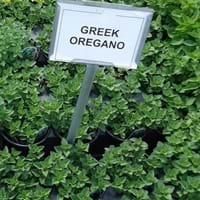Life Span
Perennial
Perennial
Origin
North America, United States, Northeastern United States, Mid-Atlantic United States, Southeastern United States, North-Central United States, South-Central United States, Texas
Mediterranean
Types
not available
Oregano maru, Lippia graveolens, Oregano tyttanthum
Number of Varieties
Not Available
Habitat
Boggy areas, Fens, Fields, meadows, Swamps, Woodlands
Open grasslands, Open scrub, Rocky areas
USDA Hardiness Zone
4-9
4-9
Sunset Zone
1a, 1b, 2a, 2b, 3a, 3b, 4, 5, 6, 7
1a, 1b, 2a, 2b, 3a, 3b, 4, 5, 6, 7, 8, 9, 10, 11, 12, 13, 14, 15, 16, 17, 18, 19, 20, 21, 22, 23, 24
Habit
Thicket/Colonizing
Clump-Forming
Flower Color
Not Available
White
Flower Color Modifier
Not Available
Bicolor
Leaf Color in Spring
Not Available
Green
Leaf Color in Summer
Not Available
Green
Leaf Color in Fall
Not Available
Green
Leaf Color in Winter
Not Available
Light Green
Leaf Shape
Oblovate
Ovate
Plant Season
Spring, Fall, Winter
Spring, Summer, Fall
Sunlight
Full Sun, Partial Sun
Full Sun, Partial Sun
Growth Rate
Medium
Medium
Type of Soil
Clay, Loam
Loam, Sand
The pH of Soil
Acidic, Neutral, Alkaline
Neutral, Alkaline
Soil Drainage
Average
Well drained
Bloom Time
Late Spring
Early Summer, Summer, Late Summer, Early Fall, Fall
Tolerances
Not Available
Drought
Where to Plant?
Ground, Pot
Container, Ground, Pot
How to Plant?
Divison, Seedlings
Stem Cutting
Plant Maintenance
Medium
Medium
Watering Requirements
Keep the ground moist but not water-logged
Average Water Needs, Do Not over Water
In Summer
Lots of watering
Lots of watering
In Spring
Moderate
Moderate
In Winter
Average Water
Average Water
Soil pH
Acidic, Neutral, Alkaline
Neutral, Alkaline
Soil Type
Clay, Loam
Loam, Sand
Soil Drainage Capacity
Average
Well drained
Sun Exposure
Full Sun, Partial Sun
Full Sun, Partial Sun
Pruning
Prune after flowering, Prune in early spring, Remove damaged leaves, Remove dead branches, Remove dead leaves
Remove damaged leaves, Remove dead branches, Remove dead leaves
Fertilizers
All-Purpose Liquid Fertilizer, Compost, Fertilize every year, Mulch, Nitrogen
All-Purpose Liquid Fertilizer
Pests and Diseases
Aphids, Apple Maggot, Fall Webworm, Red blotch, Scale
Red blotch
Plant Tolerance
Not Available
Drought
Flower Petal Number
Not Available
Single
Fragrant Bark/Stem
No
Yes
Foliage Texture
Not Available
Medium
Foliage Sheen
Not Available
Matte
Attracts
Birds
Bees, Butterflies, pollinators
Allergy
Not Available
Not Available
Aesthetic Uses
Showy Purposes
As decorated salad, Ground Cover
Beauty Benefits
Not Available
Not Available
Environmental Uses
Air purification
Air purification
Medicinal Uses
Not Available
Cold, Fever, Gastrointestinal disorders, Nerve pain, Respiratory Disorders
Part of Plant Used
Fruits
Leaves
Other Uses
Used As Food, Used as Ornamental plant
Used as a flavouring in food, Used as an ointment
Used As Indoor Plant
No
No
Used As Outdoor Plant
Yes
Yes
Garden Design
Cutflower, Mixed Border, Screening, Wind Break
Container, Edible, Herb / Vegetable, Mixed Border
Botanical Name
ARONIA arbutifolia
ORIGANUM heracleoticum
Common Name
Red Chokeberry
Greek Oregano
In Hindi
लाल Chokeberry
रामतुलसी
In German
Rote Apfelbeere
Greek Oregano
In French
Red Chokeberry
marjolaine sauvage
In Spanish
rojo Chokeberry
Greek Oregano
In Greek
κόκκινο Chokeberry
Greek Oregano
In Portuguese
Red Chokeberry
Orégano
In Polish
Red aronii
Lebiodka pospolita
In Latin
arbutifolia
Greek Oregano
Phylum
Magnoliophyta
Tracheophyta
Class
Magnoliopsida
Magnoliopsida
Family
Rosaceae
Lamiaceae
Clade
Angiosperms, Eudicots, Rosids
Angiosperms, Asterids, Eudicots
Tribe
Not Available
Not Available
Subfamily
Not Available
Not Available
Number of Species
Not Available
Not Available
Season and Care of Red Chokeberry and Greek Oregano
Season and care of Red Chokeberry and Greek Oregano is important to know. While considering everything about Red Chokeberry and Greek Oregano Care, growing season is an essential factor. Red Chokeberry season is Spring, Fall and Winter and Greek Oregano season is Spring, Fall and Winter. The type of soil for Red Chokeberry is Clay, Loam and for Greek Oregano is Loam, Sand while the PH of soil for Red Chokeberry is Acidic, Neutral, Alkaline and for Greek Oregano is Neutral, Alkaline.
Red Chokeberry and Greek Oregano Physical Information
Red Chokeberry and Greek Oregano physical information is very important for comparison. Red Chokeberry height is 180.00 cm and width 12.70 cm whereas Greek Oregano height is 30.50 cm and width 30.50 cm. The color specification of Red Chokeberry and Greek Oregano are as follows:
Red Chokeberry flower color: Not Available
Red Chokeberry leaf color: Not Available
Greek Oregano flower color: White
- Greek Oregano leaf color: Green
Care of Red Chokeberry and Greek Oregano
Care of Red Chokeberry and Greek Oregano include pruning, fertilizers, watering etc. Red Chokeberry pruning is done Prune after flowering, Prune in early spring, Remove damaged leaves, Remove dead branches and Remove dead leaves and Greek Oregano pruning is done Remove damaged leaves, Remove dead branches and Remove dead leaves. In summer Red Chokeberry needs Lots of watering and in winter, it needs Average Water. Whereas, in summer Greek Oregano needs Lots of watering and in winter, it needs Average Water.





